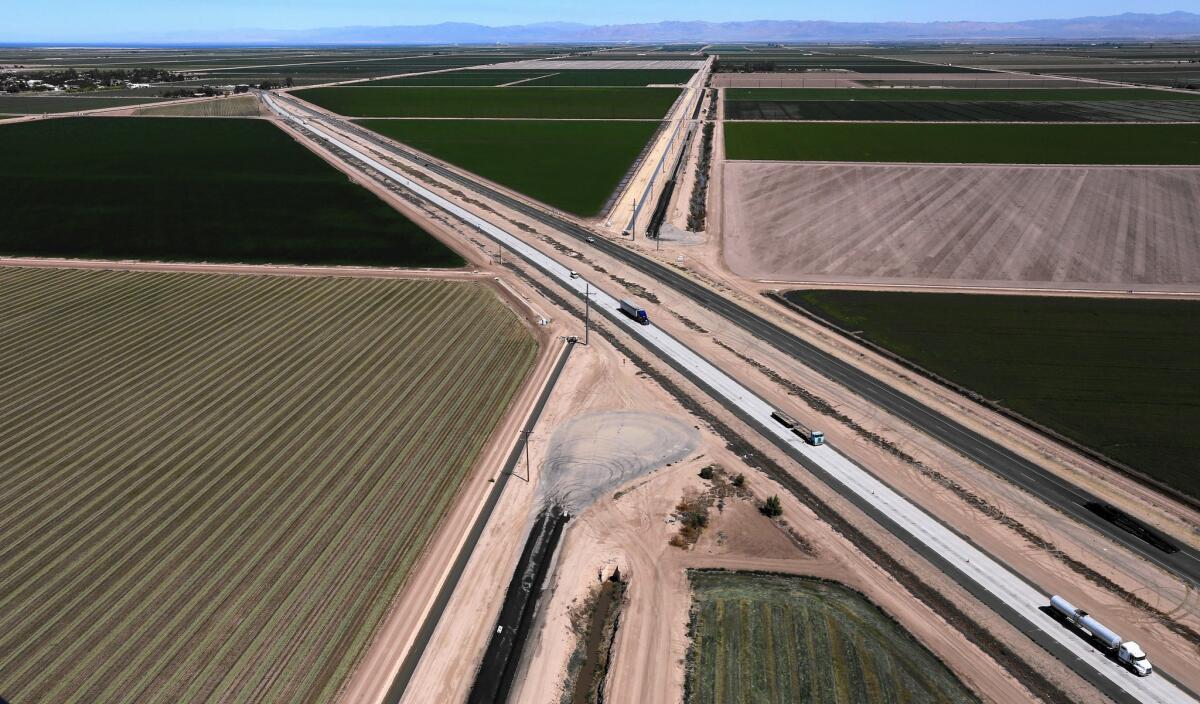Despite drought, water flowing freely in Imperial Valley

- Share via
Reporting from IMPERIAL, Calif. — A framed copy of the Imperial Press front page from June 8, 1901, hangs in a prominent spot at the Pioneers Museum here.
The newspaper’s motto says boldly: “Water Is King, Here Is Its Kingdom.” The lead story details the latest of what proved to be many advances in bringing water from the Colorado River to make the desert bloom.
Modern irrigation — aided by the Hoover Dam and the All-American Canal — transformed the Imperial Valley from a hostile desert into an agricultural marvel: a testament to generations of farmers and their use of cheap and plentiful water. Crops bring an annual harvest of more than $2 billion.
With California in its fourth year of drought, Gov. Jerry Brown has avoided targeting farmers and their water usage. But some are beginning to wonder whether the clamor will soon build for redirecting farm water to more populous areas.
And when it comes to water-rich areas with relatively few people, there is no place in California quite like the Imperial Valley.
Because of a series of laws and multi-state agreements, some dating to the 1920s and ‘30s, the Imperial Irrigation District receives 3.1 million acre-feet of water annually from the Colorado River. The rest of Southern California receives 1.3 million.
This means that 180,000 people in the Imperial Valley receive approximately 70% of California’s allocation of water from the Colorado River. The other 20 million-plus people in Southern California receive about 30%.
Of seven states that depend on the Colorado River, the Imperial district receives more water than all but Colorado. If there is a shortage on the river, as some experts predict will occur next year, Nevada, southern Arizona and Mexico will be cut back before the Imperial district loses a drop.
“If the drought continues, everyone is going to begin asking how such a small community was able to garner as much water as it has,” said Eric Boime, an associate professor of history at San Diego State who wrote his doctoral dissertation on the Imperial Valley and its water. “They’re going to realize that the Imperial Valley is the only game in town when it comes to securing more water.”
Imperial Valley farmers watch vigilantly for attempts to chip away at their water rights.
“That’s a lifelong thing for us in the valley,” said Carson Kalin, who farms 1,800 acres with his brother. “We have to be aware that everyone is looking at our water and how we use it.”
Throughout the West, a legal principle involving divvying up water holds “first in time, first in right.” When it comes to the Colorado River, the farmers and land speculators of the Imperial Valley were the first to see the potential of the river in a big way.
Much of the nation’s winter vegetables are grown in the Imperial Valley. In 2014, 75 crops were grown, from alfalfa (142,594 acres) to bamboo (1 acre).
Water is not just a commodity in the Imperial Valley. It is a hard-won legacy.
The pictures of early settlers are displayed at the Pioneers Museum, including Carson Kalin’s father, Al Kalin, described as “a giant in his field, a man of his word, a pioneer.” Kalin’s mother, Louise Willey, led the successful fight in the 1970s against the federal government to protect the valley’s water rights.
A full-page ad by the Imperial Land Co. described the lure of those early years of the last century, when the area was still part of San Diego County: land at $1.25 per acre and “the best water right in the world at the lowest price ever offered.”
Farmers and ranchers moved to the hot, windy, dusty desert from throughout the U.S. and more than a dozen countries. The latter formed ethnic enclaves. Much of the Pioneers Museum is devoted to preserving the history of those enclaves and celebrating the Imperial Irrigation District.
In dealing with issues of the past, the district has hired lawyers from El Centro, San Diego, Los Angeles and San Francisco — as well as one of the deans of Western water law, the cowboy-hat-wearing Charles DuMars, professor emeritus at the University of New Mexico.
Beyond legal muscle, the Imperial Valley has something that might surprise newcomers to the complexities of water allocation in California: a narrative that says the Imperial Irrigation District has already done more than its share to keep coastal and urban Southern California from withering up from drought.
From its 3.1-million-acre-feet allocation, the Imperial Valley farmers — as a result of several water transfer deals — provide about 500,000 acre-feet a year to other areas, enough for 1 million families.
The deals remain controversial and politically combustible, but a deal is a deal: Colorado River water that was once “owned” by the Imperial Valley is keeping lawns green in San Diego and toilets flushing in Los Angeles.
In 2003, Imperial board member Bruce Kuhn provided the swing vote to approve, by 3 to 2, the sale of water to the San Diego County Water Authority, considered the largest farms-to-cities water deal in the nation.
Kuhn said he voted in favor of the deal as a way to end the lawsuit filed by the federal government against the irrigation district aimed at taking some of Imperial’s water without compensation.
“I lost an election, I lost business, I lost friends,” Kuhn said. “Hell, yes, I paid a price.”
Kuhn, who owns a business that levels farmland to make planting and irrigating easier, is back on the governing board and hopes the Imperial Valley can avoid the rancor — and litigation — that led to the 2003 deal.
Tina Shields, the district’s interim water manager, said the Imperial district should get credit for the 500,000 acre-feet shipped elsewhere each year, for limiting the amount of water an individual farm can receive (a first for the district), and for fallowing 50,000 acres to conserve water.
When farmers exceeded the 3.1-million limit for two years, the district paid $20 million to the federal government. Before 2003, there was, in effect, no limit to the amount of water that Imperial Valley farmers could use.
“I’d say we’re doing our part” to fight drought, said Shields, whose family came to the Imperial Valley from Switzerland in the early 1900s.
So far, more attention has been paid to the water used by farmers in the Central Valley than here in the southeastern corner of the state.
Maybe the governor and other decision-makers in Sacramento know how difficult it would be to wrest more water from the Imperial Irrigation District.
“You can’t simply raid agriculture or they would have already done it,” said Kevin Kelley, a farmer’s son who is now the district’s general manager.
Others are not so sure that a “raid” is not coming.
“Once they get through with the Central Valley, they’ll come after us,” Kalin said. “We’re the elephant in the corner of the room.”
Twitter: @LATsandiego
More to Read
Sign up for Essential California
The most important California stories and recommendations in your inbox every morning.
You may occasionally receive promotional content from the Los Angeles Times.










